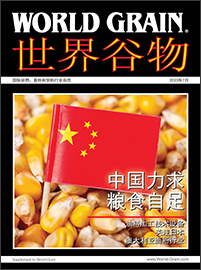WASHINGTON, DC, US — Downbound barged grain volumes are 25% lower than last year and nearly 30% lower than the five-year average on the Mississippi River system due to low export sales and dropping water levels, according to the Oct. 5 Grain Transportation Report by the US Department of Agriculture (USDA).
As of Sept. 30, year-to-date downbound barged grain volumes totaled 18.1 million tonnes, the USDA said. From the week ending July 8 to the week ending Sept. 30, volumes totaled 3.9 million tonnes, 35% lower than the third quarter last year and 53% lower than the previous five-year average.
Low water levels on the river system, which moves grain from the US Midwest to the Gulf region for export, became a problem in June, two months earlier than 2022. Nearly 60% of US grain exports travel the river system by barge.
In 2022, barge transpiration was dramatically affected due to historic low water levels. This resulted in below-average yearly grain volumes and record high freight rates.
Since this June, more stringent restrictions have been set for draft and tow sizes on various sections of the river system. The most severe restrictions are on the Lower Mississippi and Ohio rivers at Cairo, Illinois, US, the USDA said.
The restrictions mandate loading draft reductions of up to 32% and tow size reductions of 17% to 32%. Water levels on the Mississippi River at Memphis, Tennessee, US, are close to 2 feet lower than this time last year, the USDA said.
Weekly grain volumes have been down compared to last year in all but two weeks in the first quarter and four weeks in the second quarter, the USDA said.
The largest decline was seen in corn volumes, which totaled 1.5 million tonnes in the third quarter (45% lower than last year) and 9.1 million tonnes year-to-date (32% lower than last year).
The drops mainly resulted from lower export sales, the USDA said. From January through July, exports to 2022’s top 10 countries were all down double digits except for Mexico, which was up 7%. However, most exports to Mexico ship over land via rail.
Exports to China, which had been the largest buyer of US corn, were down 64% while exports to Canada, the second largest buyer, were down 71%.
“The drop in exports owed to low US corn production, a record harvest crop by Brazil, and the strong US dollar, which made Brazilian corn cheaper than US corn,” the USDA said.
Similar to corn, third-quarter 2023 barged soybeans and wheat volumes headed to the Gulf showed sizeable drops. At 1.8 million tonnes, soybean volumes were 31% while wheat volumes, at 522,000 tonnes, were 15% lower than last year.
Spot freight rates have started to creep higher, but the below-normal export sales and below-normal demand for barges have kept rates from rising until August. The average third-quarter spot freight rate at St. Louis, Missouri, US, was $15.92 per tonne, 16% higher than last year and 9% lower than the five-year average.
Looking ahead, the USDA said barged grain movements should begin to pick up in the fourth quarter as the corn and soybean harvests progress.
“However, if low-water conditions in the Mississippi River system continue, lack of precipitation may lead to increased restrictions, which would further shrink an already tight barge supply,” the USDA said. “The rising harvest demand and shrinking barge supply may lead to above-average spot rates that approach last year’s record rates.
“However, lessons learned last year and early preventive measures may help mitigate conditions that created record-high spot rates seen in 2022.”




